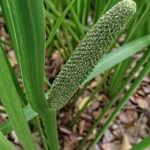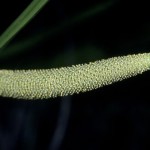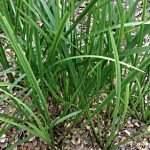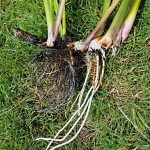Sweet Flag Root – Acorus calamus
|
Current Demand = Good |
Parts Used: Root |
 |
 |
 |
 |
Family: Acoraceae
Common Names: Cinnamon sedge, Flagroot, Gladdon, Myrtle Flag, Myrtle grass, Myrtle sedge, sweet cane, sweet root and sweet rush…
Description:
Sweet Flag is a tall perennial grass-like plant, resembling an iris. It scented leaves and roots that are used for medicinal purposes, especially as a psychotropic drug. In particular the plant likes wet areas like the edges of streams, around lakes and ponds and in ditches. It often shares the area with the common cat-tail.
The thick erect leaves are similar to an iris but the edges are crimped and they resemble a sword shape. They are bright yellow, with a pink or red base. The leaf show 2-6 major veins and tend to have a tangerine odor.
The plant rarely has flowers or set fruit, but when they do, the flowers are round with greenish brown and covered with spikes. The fruits are small and berry like with a few seeds. The flowers bloom from early to late summer.
The roots are long and creeping that spread out just below the surface. They can reach over 6 feet in length and spread horizontally. They have a brownish-red bark and a white, fleshy interior and usually 1-2 inches thick.
Planting/Cultivation:
Sweet flag is propagated by rhizome division. This is best done in the spring and fall, using at least a 5-6 cm piece of root. The root must be firm, clean and aromatic, and free of any damage or infection. The plant will grow most anyplace, but prefers sunshine and lots of water.
Seed: these need to be planted during the fall or winter in a greenhouse using an organic soil mix, scatter seed sparsely on the surface and press firmly into the soil. Keep the soil moist. It will germinate within 2 weeks. Transplant when they reach a height of 2-3 inches into individual pots. When spring comes, put outdoors at least one foot apart. See harvesting/drying next
Harvesting/Drying:
Parts Used: root
The rhizomes are collected in the spring before new growth or in late fall. It is better if the plants are 2-3 years old before the first harvest is done. If left longer than this, they become hollow. The leaves and the rootlets should be removed and the rhizomes washed. Then quickly dry the rhizome without using heat, preferable a warm room. After drying, the rhizome loses 70-75% of its weight, but the flavor and aroma improve.
They should be stored in a cool dry place, but not longer than one year. After this the roots has lost most of its active principle. The fragrance increases during the drying process.
Attributes (Images)
By Mokkie (Own work) [CC BY-SA 3.0], via Wikimedia Commons
By Mokkie (Own work) [CC BY-SA 3.0], via Wikimedia Commons
By Krzysztof Ziarnek, Kenraiz (Own work) [CC BY-SA 3.0], via Wikimedia Commons
 Root Buyer
Root Buyer